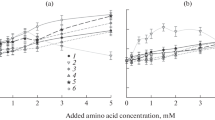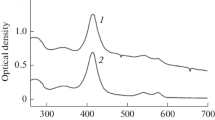Abstract
Cultures ofStaphylococcus aureus, which are harvested from the stationary phase of growth, are extremely resistant to lysis by extracts of human blood leukocytes. Such bacteria are, however, rendered susceptible to bacteriolysis when cultivated in the presence of subinhibitory concentrations of penicillin G, nafcillin, or cloxacillin (0.05μg/ml). The lytic effect of the leukocyte extracts on the penicillin-grown bacteria is further augmented by the addition of egg-white lysozyme. Staphylococci, which are harvested from the logarithmic phase of growth in ordinary media, are susceptible to lysis by leukocyte extracts, maximal lysis being achieved with about 100μg/ml of leukocyte extracts. On the other hand, penicillin-grown staphylococci are lysed by much smaller amounts of leukocyte extracts (20μg/ml), and much shorter periods of incubation are needed to achieve maximal lysis. Similar results are obtained when the leukocyte extracts are substituted by a cocktail of lytic agents which contain crude trypsin, lysolecithin, and lysozyme. Lysis of the staphylococci by the leukocyte extracts, fortified by lysozyme, is optimal at pH 5.0 and is accompanied by the solubilization of the bulk of glucosamine, known to be mostly concentrated in the peptidoglycan of the cell wall. Penicillin-grown staphylococci are also more susceptible than controls to lysis by a mixture of histone and lysozyme. The lysis, by leukocyte extracts and by the cocktail of both regular and penicillin-grown staphylococci, is strongly inhibited to the same extent by heparin, liquoid, histone, protamine sulfate, IgG, and human serum. On the other hand, no inhibition of lysis is achieved by chloramphenicol, streptomycin, erythromycin, KCN, HgCl2, or by neutral polyelectrolytes. Group A streptococci, which are extremely resistant to degradation by leukocyte extracts or by the cocktail, when harvested from any phase of growth, also become susceptible to lysis by leukocyte extracts or by the cocktail when grown in the presence of small amounts of penicillin (0.004–0.008μ/ml). Bacteriolysis became even more pronounced when the reaction mixtures were incubated at 41 °C, a temperature likely to develop in patients with streptococcal infections. Electron-microscope examination of the staphylococci following treatment with leukocyte enzymes and penicillin revealed that both cell wall and cytoplasmic structures were severely damaged by the lytic agents. The mechanisms by which penicillin exposes the bacterial cell walls to cleavage by leukocyte extracts is discussed, and the phenomenon of enhanced susceptibility to lysis by leukocyte enzymes is related to the role played by undegraded bacterial constituents in the initiation of chronic inflammatory lesions.
Similar content being viewed by others
References
Lahav, M., N. Ne'eman, E. Adler, andI. Ginsburg. 1974. The effect of leukocyte hydrolases on bacteria. I. Degradation of14C-labeled streptococci and staphylococci by leukocyte lysates in vitro.J. Infect. Dis. 129:528.
Ne'eman, N., M. Lahav, andI. Ginsburg. 1974. The effect of leukocyte hydrolases on bacteria. II. The synergistic action of lysozyme and extracts of PMN, macrophages, lymphocytes and platelets in bacteriolysis.Proc. Soc. Exp. Biol. Med. 146:1137.
Lahav, M., N. Ne'eman, J. James, andI. Ginsburg. 1975. The effect of leukocyte hydrolases on bacteria. III. Bacteriolysis induced by extracts of different leukocyte populations and the inhibition of lysis by macromolecular substances.J. Infect. Dis. 131:149.
Ginsburg, I., N. Ne'eman, Z. Duchan, M.N. Sela, J. James, andM. Lahav. 1975. The effect of leukocyte hydrolases on bacteria. IV. The role played by artificial enzyme “cocktails” and tissue enzymes in bacteriolysis.Inflammation 1:41.
Sela, M.N., M. Lahav, N. Ne'eman, Z. Duchan, andI. Ginsburg. 1975. The effect of leukocyte hydrolases on bacteria. V. Modification of bacteriolysis by antiinflammatory agents and by cationic and anionic polyelectrolytes.Inflammation 1:57.
Ginsburg, I., M. Lahav, N. Ne'eman, Z. Duchan, S. Chanes, andM.N. Sela. 1975. The interaction of leukocytes and their hydrolases with bacteria in vitro and in vivo: The modification of the bactericidal and bacteriolytic reactions by cationic and anionic macromolecular substances and by antiinflammatory agents.In Future Trends in Inflammation. II. Agents and Actions. Vol. 6, p. 292.
Warren, G.H., andJ. Gray. 1965. Effect of sublethal concentrations of penicillins on the lysis of bacteria by lysozyme and trypsin.Proc. Soc. Exp. Biol Med. 120:504.
Myrvik, Q.N., E.S. Leake, andB. Fariss. 1961. Studies on the pulmonary alveolar macrophages from the normal rabbit: A technique to produce them in a high state of purity.J. Immunol. 86:128.
Ginsburg, I., M.Lahav, N.Ne'eman, and J. M.James. 1974. The inhibition by byasic and acidic polyelectroytes of the degradation of bacteria by leukocyte enzymes: Relation to the persistence of microbial constituents in inflammatory sites.In Activation of Macrophages, Second Workshop Conferences Hoechst. W.H. Wagner and H. Hahn, editors. Excerpta Medica Publications 162.
Gatt, R., andE.R. Berman. 1966. A rapid procedure for the estimation of amino sugars or a micro scale.Anal. Biochem. 15:167.
Fischetti, V.A., E.C. Gotschlich, andA.W. Bernheimer. 1971. Purification and physical properties of group C phage-associated lysin.J. Exp. Med. 133:1105.
McCarty, M. 1952. The lysis of group A hemolytic streptococci by extracellular enzymes ofStreptomyces albus. I. Production and fractionation of the lytic enzymes.J. Exp. Med. 96:555.
Schwab, J.H., andS.H. Ohanian. 1967. Regulation of streptococcal cell wall antigens in vitro.J. Bacteriol. 94:1346.
Ginsburg, I. 1972. Mechanisms of cell and tissue injury induced by group A streptococci: Relation to poststreptococcal sequelae.J. Infect. Dis. 126:294.
Gallis, H.A., and R.W.Wheat. 1974. Degradation of 14C-labeled cell walls of group A streptococci by lysozyme and lysosomal enzymes.Am. Sci. (abstract).
Hayashi, H., Y. Araki, andE. Ito. 1973. Occurrence of glucosamine residues with free amino groups in cell wall peptidoglycan from bacilli as a factor responsible for resistance to lysozyme.J. Bacteriol. 113:592.
Wagner, B., andM. Wagner. 1975. Immunoelectron microscopic localization of cell wall antigens in streptococci. II. Localization of the group-specific polysaccharide of group C streptococci with ferittin and peroxidase-labeled Helix pomatia agglutinin.261 Bakt. Hyg. I. Abt. Orig. A. 231:81.
Park, J.T., J.R. Edwards, andE.M. Wise, Jr. 1974. In vivo studies on the uptake and binding of β-lactam antibiotics in relation to inhibition of wall synthesis and cell death.Ann. N. Y. Acad. Sci. 235:300.
Noller, E.C., andS.E. Hartsell. 1961. Bacteriolysis of enterobacteriaceae. I. Lysis by four lytic systems utilizing lysozyme.J. Bacteriol. 81:482.
Zeya, H.I., andJ.K. Spitznagel. 1966. Cationic proteins of polymorphonuclear leukocyte lysosomes. II. Composition properties and mechanisms of antibacterial action.J. Bacteriol. 91:755.
Hirsch, J.G. 1958. Bactericidal action of histone.J. Exp. Med. 108:925.
Brumfitt, W., A.C. Wardlaw, andJ.T. Park. 1958. Development of lysozyme-resistance inMicrococcus lysodeikticus and its association with an increasedO-acetyl content of the cell wall.Nature 181:1783.
Mandelstam, M., andJ.L. Strominger. 1961. On the structure of the cell wall ofStaphylococcus aureus (Copenhagen).Biochem. Biophys. Res. Commun. 5:466.
Ginsburg, I., andM.N. Sela. 1976. The role of leukocytes and their hydrolases in the persistence, degradation and transport of bacterial constituents in tissues: Relation to chronic inflammatory processes in staphylococcal, streptococcal and mycobacterial infections and in chronic periodontal disease.Crit. Rev. Microbiol. 4:249.
Morse, S.I. 1965. Biological attributes of staphylococcal cell walls.Ann. N.Y. Acad. Sci. 128:191.
Krause, R.M., andM. McCarty. 1961. Studies on the chemical structure of the streptococcal cell wall.J. Exp. Med. 114:127.
Perkins, H.R. 1965. The action of hot formamide on bacterial cell walls.Biochem. J. 95:876.
Strominger, J.L., andJ.M. Ghusen. 1968. Mechanism of enzymatic bacteriolysis.Science 156:213.
Fleck, J., J.P. Martin, andM. Mock. 1974. Action of lysozyme on penicillin-induced filaments ofProteus vulgaris.J. Bacteriol. 120:929.
Suganuma, A. 1972. Fine structure of staphylococci: Electron microscopy.In The Staphylococci, J.O. Cohen, editor. Interscience, New York.21.
Makao, M., E. Kitanaka, K. Ochiai, andS. Nakazawa. 1972. Cell wall synthesis inStaphylococcus aureus in the presence of protein synthesis inhibitory agents. I. Lincomycin, clindomycin, macrolide antibiotics.Jpn. J. Microbiol. 16:403.
Schwab, J.H., W.J. Cromartie, J.H. Ohanian, andJ.E. Craddock. 1967. Association of experimental chronic arthritis with the persistence of group A streptococcal cell walls in the articular tissue.J. Bacteriol. 94:1728.
Stein, H., R. Yarom, S. Levine, T. Dishon, andI. Ginsburg. 1973. Chronic and self-perpetuating arthritis induced in the rabbit by cell-free extracts of group A streptococci. I. Description of the model.Proc. Soc. Exp. Biol. Med. 143:1106.
Page, C.R., P. Davies, andA.C. Allison. 1974. Participation of mononuclear phagocytes in chronic inflammatory diseases.J. Reticuloendothel. Soc. 15:413.
Ginsburg, I., andR. Trost. 1971. Localization of group A streptococci and titanium dioxide particles in arthritic and hepatic lesions in the rabbit.J. Infect. Dis. 123:792.
Ginsburg, I., S. Mitrani, N. Ne'eman, andM. Lahav. 1975. Granulomata in streptococcal inflammation: Mechanisms of localization transport and degradation of streptococci in inflammatory sites.In Mononuclear Phagocytes in Immunity, Infection and Pathology. R. van Furth, editor. Blackwell Scientific, Oxford. 981.
Author information
Authors and Affiliations
Additional information
This study was supported by grants from the Joint Research Fund of The Hebrew University-Hadassah School of Dental Medicine founded by the Alpha Omega Fraternity and The Hadassah Medical Organization, and by grants from The Chief Scientist, The Ministry of Health, Government of Israel.
This study forms part of an M.Sc. thesis submitted to the Institute of Microbiology, Faculty of Medicine, Hebrew University-Hadassah Medical Center, Jerusalem, Israel.
Rights and permissions
About this article
Cite this article
Efrati, C., Sacks, T., Ne'eman, N. et al. The effect of leukocyte hydrolases on bacteria VIII. The combined effect of leukocyte extracts, lysozyme, enzyme “cocktails,” and penicillin on the lysis ofStaphylococcus aureus and group a streptococci in vitro. Inflammation 1, 371–407 (1976). https://doi.org/10.1007/BF00920338
Issue Date:
DOI: https://doi.org/10.1007/BF00920338




